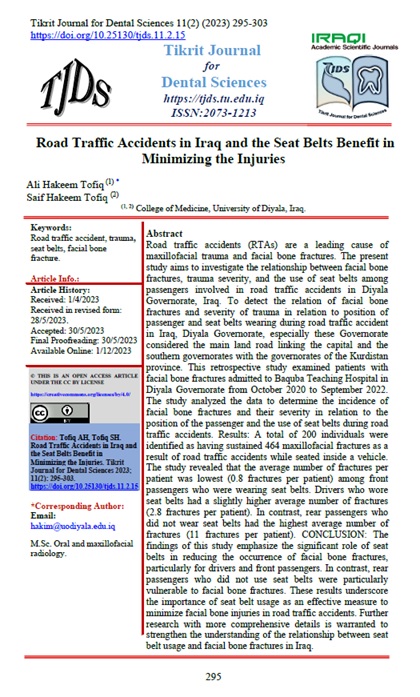Road Traffic Accidents in Iraq and the Seat Belts Benefit in Minimizing the Injuries
Ali Hakeem Tofiq
College of Medicine, University of Diyala, Iraq
Saif Hakeem Tofiq
College of Medicine, University of Diyala, Iraq
DOI: https://doi.org/10.25130/tjds.11.2.15
Keywords: Road traffic accident, trauma, seat belts, facial bone fracture
Abstract
Road traffic accidents (RTAs) are a leading cause of maxillofacial trauma and facial bone fractures. The present study aims to investigate the relationship between facial bone fractures, trauma severity, and the use of seat belts among passengers involved in road traffic accidents in Diyala Governorate, Iraq. To detect the relation of facial bone fractures and severity of trauma in relation to position of passenger and seat belts wearing during road traffic accident in Iraq, Diyala Governorate, especially these Governorate considered the main land road linking the capital and the southern governorates with the governorates of the Kurdistan province. This retrospective study examined patients with facial bone fractures admitted to Baquba Teaching Hospital in Diyala Governorate from October 2020 to September 2022. The study analyzed the data to determine the incidence of facial bone fractures and their severity in relation to the position of the passenger and the use of seat belts during road traffic accidents. Results: A total of 200 individuals were identified as having sustained 464 maxillofacial fractures as a result of road traffic accidents while seated inside a vehicle. The study revealed that the average number of fractures per patient was lowest (0.8 fractures per patient) among front passengers who were wearing seat belts. Drivers who wore seat belts had a slightly higher average number of fractures (2.8 fractures per patient). In contrast, rear passengers who did not wear seat belts had the highest average number of fractures (11 fractures per patient). CONCLUSION: The findings of this study emphasize the significant role of seat belts in reducing the occurrence of facial bone fractures, particularly for drivers and front passengers. In contrast, rear passengers who did not use seat belts were particularly vulnerable to facial bone fractures. These results underscore the importance of seat belt usage as an effective measure to minimize facial bone injuries in road traffic accidents. Further research with more comprehensive details is warranted to strengthen the understanding of the relationship between seat belt usage and facial bone fractures in Iraq.




